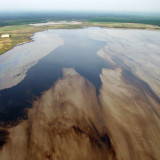
EDMONTON – Oilsands producers are talking with the federal and Alberta governments about conditions under which water from the industry’s tailings ponds could be released into the environment.
Officials say releases would only involve treated water and wouldn’t happen until the end of a mine’s life.
Environmentalists are watching the discussions closely and warn that quality standards for released tailings water should be high.
“If they’d be willing to take the water and dump it in the Bow River near Calgary, then perhaps,” said Keith Stewart of Greenpeace.
Alberta has a zero discharge policy for the oilsands. No water affected by processing is allowed back into the Athabasca River and even rain that falls on developed sites must be collected and stored.
Most of that water is kept in tailings ponds.
Companies failing to meet regulations for tailings ponds
The ponds — covering 170 square kilometres with a toxic blend of hydrocarbons, silt, salts and heavy metals — have been a lingering headache for the industry. Alberta’s energy regulator has already had to relax on enforcing regulations about cleaning up the ponds after companies pleaded they would simply be unable to meet their targets.
But as the province develops new tailings regulations, there is general acknowledgment that something will have to be done with the water currently filling the ponds once contaminants have been removed and stored at the bottom of so-called end-pit lakes. Said department spokeswoman Nikki Booth in an email:
[quote](Alberta Environment) is consulting on a tailings management framework with industry and First Nations. Included in that consultation are discussions about introducing tailings water (free of the tailings) back into natural waterways at the end of a project.[/quote]
Those discussions have been occurring for some time. Documents obtained under Access to Information laws refer in the summer of 2012 to “the industry request for tailings release as a management option.”
Federal environment spokesman Mark Johnson confirmed that reference.
“A small number of oil and gas stakeholders … have expressed an interest in a science-focused dialogue with experts from Environment Canada and Alberta Environment and Sustainable Development on the environmental considerations of water management, including release of tailings ponds water by the oilsands sector.”
Industry downplays concerns
Greg Stringham of the Canadian Association of Petroleum Producers said the only interest he’s aware of involves water in tailings ponds at the end of a mine’s life.
“We’re going to have extra water left over that needs to be treated and processed and put back into the environment in some sense. We’ve started talking about how that will happen at the end of the mine life.
“There’s no current request to release anything in place.”
That’s small comfort, said Stewart. He points out that the reason the tailings ponds have been such an intractable problem is because it’s so difficult to get impurities such as salts and heavy metals out of the water. Stewart notes:
[quote]The problem they’ve had is that they can’t get the stuff out of the water and they’ve been trying for 40 years. For 40 years we’ve been hearing we’re just about to solve this problem and we haven’t.[/quote]
Not only is the cleanup proving difficult, it’s also expensive, Stewart said. He fears industry is lobbying government to allow it to release some level of process-affected water back into the environment.
Stringham said any released water would meet government standards.
“What we’re looking at is the water that would be liberated from tailings during the reclamation process that would then be treated to meet all the environmental criteria, and then put back into the environment.”
Booth suggested Alberta is approaching the idea with caution.
“More work is needed on treatment technology and science,” she said. “If potential technology is developed that may allow for tailings water to be released into the natural environment, then it may be something government would consider at that time.”


I was a Water Fuel Environment tech with National Defense for 11 years. We ran an oily waste separation plant that discharged 10 million litres a year to a Municipal sewage system. We used a number of technologies at the facility over the years. The latest upgrade included an Electric Coagulation technology that was capable of removing heavy metals and residual oils. That system could only treat 10-20 thousand litres a day. We turning the separated floc into sludge with a large press. Sampling and analysis was required for every discharge. As a plant operators, we observed the process benefits by analyzing in-fluent and effluent test results to adjust our process. I’m one of a very small group of skilled technicians that are familiar with this system…and get this!…I’m unemployed!
I wont work for a polluter on ethical grounds, but someday I expect a clean up company will pick me up. It’s a shame what Alberta has done to it’s lands and rivers!
??? are you guys dumb? fukashima has vented more cesium 137 in the last 24 months than this story ever could in 50 years …. you are already dead
Uhhh.. NEVER’??? why on earth would they think this a good idea… it’s almost as bad asNew York’s idea to use the fracking slime for road de-icer .. completely and utterly stupid!!!
Have they lost their minds ?
centrifuge all waste and make the companies reuse and not use fresh anymore problem solved .I will work itself out charge more if they use fresh water than it would be to clean and reuse tailings water its all about the money ya know!!!!!!!!! Experienced centrifuge specialist!!
I’ve found that centrifuges tend to emulsify the product…
Why do I keep hearing a chant in my head — Sydney tar pits — Sydney tar pits… How long did it take to clean that up (if it actually is)?